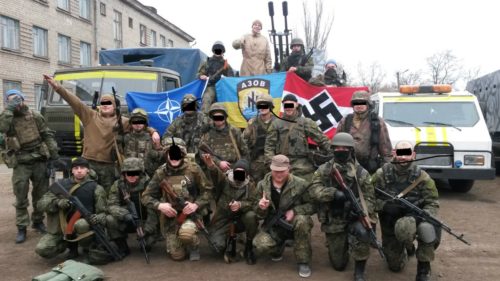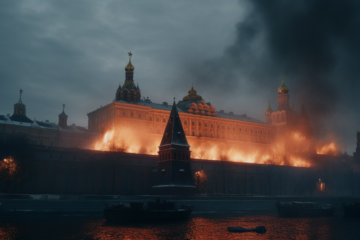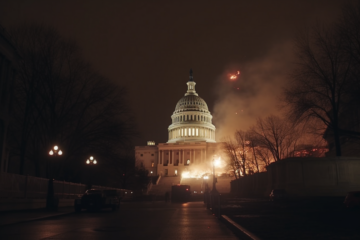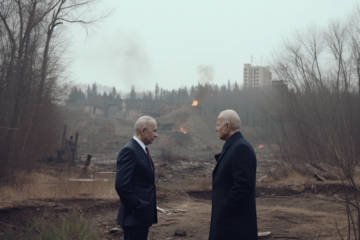Ukraine’s Faux “Nazis”
LITTLE WAS KNOWN of Ukraine’s far right until, in February 2014, an American-backed coup ousted Ukrainian President Yanukovych. The president’s popularity was average for much of Europe. Public protests tend to be non-violent but turn vicious when organised well-funded firebrands seize control. (ILLUSTRATION: Members of the Azov Battalion with NATO and Hitler Youth flags; is “Azov” Ukrainian for “confused”?)
Having spurned the U.S. agenda, Yanukovych “had to go.” Washington DC is not particular who it funds when it wants regime change. The only group that ticked enough boxes to carry out the coup were the far right, many of whom are sympathisers of Stepan Bandera. Fiercely separatist, the Banderas are named after pre-war nationalist Stephan Bandera (1909 – 1959).
Claims that the Banderas are “neo-Nazis” are false. Sure, some of their insignia bears the wolf’s claw derivative of the swastika. Before World War Two the swastika and variations were as widely used as the Christian cross. The raised arm salute was also commonly used; for instance by followers of America’s Francis Bellamy and similar nationalist-minded organisations.
When they were entering Ukraine in June 1941, the German troops were greeted as liberators. The less welcoming admirers of Bandera added German troops to their roll call of death. Evidence suggests that Stephan was possibly a Bolshevik agent. Why else was this supposedly anti-Bolshevik terrorist released by Soviet dictator Joe Stalin in September 1939? Was he betraying his comrades to the NKVD? If Bandera was a National Socialist, as the media would have us believe, why were he, his brother, and henchmen arrested by Reich police on June 30, 1941? Placed in German concentration camps, Stephan’s brother Oleksandr Andriyovych Bandera died of typhus in Auschwitz in July in 1942.
Some Bandera cohorts were vacuumed up into the Red Army whilst others transferred their loyalties to the Reich. At the time of the German invasion, the Reich had neither manpower nor intention to permanently occupy Ukraine. The objective was that, after expelling the Bolsheviks, Ukraine would be returned to independence to then act as a buffer between the Reich and the Soviets. Of the Ukrainians who fought for the Reich, just a handful were Banderas.
Today’s Azov Battalion, the balaclava-wearing spearhead of the Ukrainian far-right, hotly deny the “Nazi slur.” Quote:
We are extremely surprised and profoundly outraged by these remarks. Our battalion has always embraced patriotism and has never adopted other world ideologies.
Oleh Tyahnybok, leader of Svoboda Party, is one of the most powerful figures in the country. Tyahnybok praised the UIA and the Organization of Ukrainian Nationalists led by Stepan Bandera, who:
fought against the Russians, Germans, Jews and other scum who wanted to take away our Ukrainian state.
Historian David Marples summarizes the intermittently close relationship between Bandera and National Socialist Germany as ‘ambivalent,’ tactical, and opportunistic, with both sides trying to exploit the other unsuccessfully. Stephan Bandera was again released by Stalin in September 1944. After the war Bandera lived in Munich. Possibly because he had served his purpose and had too much information he was gunned down by the KGB in 1959.
* * *
Source: Renegade Tribune









